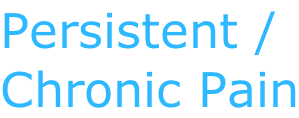


Pain Management
With persistent or chronic pain, pain signals are consistently being sent through the nervous system for weeks, months, even years. The pain may cause inflammation and the contraction of muscles around the injured area and the nerve itself. These responses are designed to protect the area from further injury -
Persistent pain may begin with an initial injury or illness, such as a long-
Some people also suffer from chronic pain despite no past injury or evidence of damage to the body.
A sudden onset of pain is referred to as acute pain, is useful in warning us of injury and is usually met with a response triggered by the nervous system to make you aware of a possible threat of injury.
Chronic pain is pain that lasts for longer than six months. In some cases the pain may worsen as the nerve fibers which transmit pain signals to the brain become more efficient and effective at sending these messages to the brain. This means that the intensity will increase to more than is necessary to get your attention and thus your brain will become more sensitive to pain. This type of pain serves little purpose -
More About Pain
The World Health Organisation have recommended a pain ladder which helps healthcare providers to determine the appropriate treatment for chronic pain so that unnecessary prescriptions for strong drugs are avoided.
According to the criteria mild pain is self-
Moderate pain is categorised as worse than mild pain to the point that it interferes with function and can't be ignored during daily life and will also require stronger medication than mild. Severe pain is defined as pain which interferes with daily life and may confine the sufferer to bed rest. This pain does not go away over time and instead requires continuous treatment.
Types of pain
General Somatic Pain
General somatic pain is the awareness of bodily harm, for example the pain caused by your body reacting to a stimulus such as a physical fight or a chemical irritant. This kind of pain will usually improve in a few days but some people develop pain which does not go away so easily. Fibromyalgia and chronic back pain fall into this category and common treatments for this form of pain include anti-
Visceral Pain
Visceral pain is the term used to describe discomfort caused by the internal organs. This pain is often difficult to determine as the connections between the pain sensors in the internal organs and the brain are not as effective as the nerves in the outer body.
Most people will have experienced a mild form of this pain when suffering from acid indigestion, which is common and easy to treat using non prescription medications. More serious forms include chronic pancreatitus which is inflammation of the pancreas, gallstones and appendicitis.
Bone Pain
Temporary bone pain can be caused by a fracture or bruise and will usually result in a throbbing sensation. This kind of pain can also be long term, occurring in individuals suffering from bone cancer, osteoporosis, osteomyelitis or arthritis. In cases such as these individuals may require long-
Muscle Spasm
Muscle cramps and spasms can cause severe pain and may require muscle relaxants and pain medication in combination.
Peripheral Neuropathy
Peripheral neuropathy is caused by a problem with the nerves which carry information to and from the brain and spinal cord and throughout the rest of the body. This process can lead to pain, inability to control muscles and a sensation similar to that of pins and needles among other side effects. This kind of nerve pain can be treated using tricyclic antidepressants and more severe nerve pain such as sharp and stabbing pains is sometimes treated with anticonvulsants.
Often individuals who have lost a limb experience peripheral neuropathy as for some people it will feel like the limb which has been lost is still present. This causes a huge amount of discomfort which is known as deafferentation, or 'phantom limb pain'. The pain can be treated with clonidine (Catapres), which is a blood pressure medicine which is effective at relieving nerve pain.
Peripheral neuropathy can also be caused by ruptured discs in the spine, cancer which effects nerves and causes irritation, infections such as shingles and diseases such as diabetes and AIDS.
Circulatory Problems
Poor circulation can be caused by excessive tobacco use, diabetes and various autoimmune diseases such as lupus. If left untreated poor circulation can lead to chronic pain, which in many cases is caused by that particular part of the body being starved of oxygen and nourishment.
Poor circulation can also be caused by reflex sympathetic dystrophy (RSD), which is characterised by painful nerve transmissions which cause the blood vessels to become narrower. This process means that not enough oxygen is able to reach the part of the body which is affected. This problem can be treated using an operation which stops the nerve impulses from narrowing the blood vessels.
Headaches
Headaches exist in many forms and occur as a result of numerous illnesses. There are also various types of headaches, ranging from migraines and tension headaches through to cluster headaches. Recommended treatment will depend entirely on the kind of headaches and the severity of the pain experienced.
Treatment Options for Persistent Pain
Often a health care provider will prescribe medications such as long-
Other avenues of treatment could include non prescription medications such as paracetamol, nerve blocks, electrical stimulation, physiotherapy, surgery, psychological counselling, behaviour modification and alternative treatments such as acupuncture, relaxation and hypnotherapy.
Hypnotherapy for pain management can either be used either alongside prescribed medication or alone, but if you are considering hypnosis then it is essential you have been to visit your GP for an appropriate medical evaluation before proceeding.
Pain is often a warning signal of a more serious underlying medical condition, for example a serious case could see an individual experiencing migraines which are a symptom of a brain tumour. If a hypnotherapist was to then go on and treat the migraines before the root cause of the problem had been found, this could lead to the tumour remaining undiagnosed.
Once the patient has been to see the doctor and the pain has been diagnosed with more serious causes having been eliminated, it is then fine for hypnotherapy treatment to commence.
Hypnotherapy can be used to manage numerous instances of pain, including irritable bowel syndrome, sciatica, spinal stenosis, burns, joint pain, neck pain and a variety of other injuries and illnesses. It is often used in Scotland by dentists for surgery. Promoting the relaxation of chronically tense muscles, allowing trapped and inflamed nerves to be released, prompting changes in brain metabolism and the switching off of nerves jammed in a “switched on” mode can bring fast and effective relief that continues for some time after the session.
As well as using certain hypnotherapy techniques such as suggestion hypnotherapy, and visualisation, I also use Neuro-
I also include self-
To request a free initial consultation press here now.


